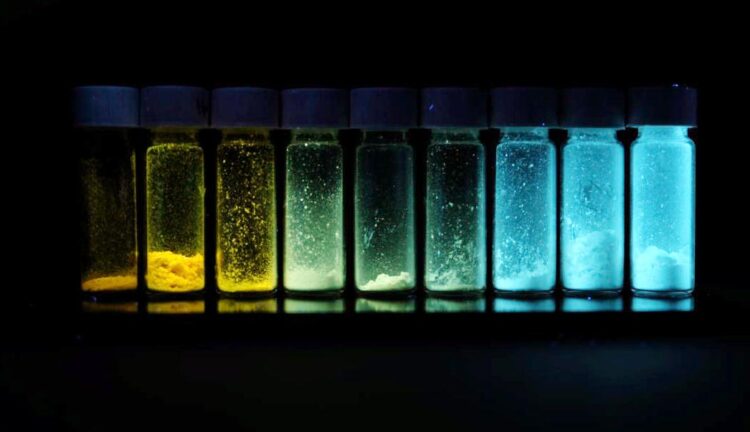Chain length determines molecular colour

Diese mit UV-Licht beschienenen Polymere sind aus den exakt gleichen Bestandteilen zusammengesetzt. Sie unterscheiden sich ausschliesslich in ihrer Kettenlänge.
Suiying Ye / ETH Zürich
Around the world, a huge amount of research and development work is currently being done on carbon-containing, or organic, molecules that emit coloured light after appropriate excitation. This research field is driven by the display industry and the development of biomedical imaging techniques.
While precise colour tuning in organic fluorescent dyes has so far usually been achieved by mixing different molecules, ETH researchers have now developed an approach that can generate a broad palette of colours by way of chemical adjustments within the molecules themselves.
Yinyin Bao, a group leader in the group of ETH professor Jean-Christophe Leroux, and his team of scientists turned to fluorescent organic polymers for this work. These polymers can best be thought of as moving chains of varying lengths. “The chains have a symmetrical structure, and two components within them contribute to the fluorescence,” Bao explains.
“One component, called the fluorophore, sits in the middle of the chain, while the other component occurs once at each of the chain’s two ends.” Joining the fluorophore in the middle of the chain with each end of the chain are links whose number and structure scientists can adjust. If the polymer chain is bent so that one of its ends comes to lie near the fluorophore and the chain is simultaneously irradiated with UV light, it fluoresces.
Distance affects the interaction
The scientists have now been able to show that the fluorescence colour depends not only on the structure of the chain links and ends, but also on the number of chain links. “It’s the interaction of the chain end and the fluorophore that’s responsible for the fluorescence of these polymers,” Bao says: “The distance between the two components affects how they interact and thus the colour that’s emitted.”
Using a method called living polymerisation, the researchers can regulate the number of chain links. First, they gradually grow the chain by a slow process of attaching building blocks to the fluorophore. Once the desired length is reached, the scientists can terminate the process and simultaneously generate the chain end molecule. This is how the researchers produced polymers with different colours: with fewer than 18 building blocks, the molecules fluoresce yellow; with 25 chain links, green; and with 44 or more links, blue. “What’s special about this is that these differently luminescent polymers are all composed of the exact same components. The only difference is the chain length,” Bao says.
Wide colour range OLEDs
The research team, including scientists from the group of ETH Professor Chih-Jen Shih and from the Royal Melbourne Institute of Technology in Australia, published their work in the journal Science Advances. Currently, the researchers can produce fluorescent polymers in yellow, green and blue, but they are working on extending the principle to include other colours, including red.
These new fluorescent polymers can’t be used directly as OLEDs (organic LEDs) in displays because their electrical conductivity is not sufficiently high, Bao explains. However, it ought to be possible to combine the polymers with semiconducting molecules in order to produce wide colour range OLEDs in a simple way. Used in concentrated solar power plants, they could also collect sunlight more efficiently and thus increase the plants’ efficiency. Bao sees their main areas of application in laboratory diagnostic procedures that use fluorescence, for example in PCR, as well as in microscopy and imaging procedures in cell biology and medicine. Other potential uses would be as security features on banknotes and certificates or in passports.
###
Reference
Ye S, Tian T, Christofferson AJ, Erikson S, Jagielski J, Luo Z, Kumar S, Shih CJ, Leroux JC, Bao Y: Continuous colour tuning of single-fluorophore emission via polymerisation-mediated through-space charge transfer. Science Advances, 7 April 2021, doi: 10.1126/sciadv.abd1794
All latest news from the category: Life Sciences and Chemistry
Articles and reports from the Life Sciences and chemistry area deal with applied and basic research into modern biology, chemistry and human medicine.
Valuable information can be found on a range of life sciences fields including bacteriology, biochemistry, bionics, bioinformatics, biophysics, biotechnology, genetics, geobotany, human biology, marine biology, microbiology, molecular biology, cellular biology, zoology, bioinorganic chemistry, microchemistry and environmental chemistry.
Newest articles

Innovative 3D printed scaffolds offer new hope for bone healing
Researchers at the Institute for Bioengineering of Catalonia have developed novel 3D printed PLA-CaP scaffolds that promote blood vessel formation, ensuring better healing and regeneration of bone tissue. Bone is…

The surprising role of gut infection in Alzheimer’s disease
ASU- and Banner Alzheimer’s Institute-led study implicates link between a common virus and the disease, which travels from the gut to the brain and may be a target for antiviral…

Molecular gardening: New enzymes discovered for protein modification pruning
How deubiquitinases USP53 and USP54 cleave long polyubiquitin chains and how the former is linked to liver disease in children. Deubiquitinases (DUBs) are enzymes used by cells to trim protein…



